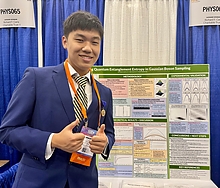High School Student Earns Accolades for 2023 Summer Research with Gorshkov Group

Image caption: Jason Youm in front of his presentation poster at the 2024 Regeneron International Science and Engineering Fair, which attracts high school students from around the world who earn qualifying spots at local science fairs. Photo by Nathalie Fuentes
A local high school student who worked with QuICS Fellow Alexey Gorshkov last year during a summer internship has placed among the top dozen competitors in the physics and astronomy category at the Regeneron International Science and Engineering Fair (ISEF).
Jason Youm, a rising senior at Montgomery Blair High School in Silver Spring, Maryland, attended the ISEF competition in May, presenting work he completed in 2023 under the mentorship of Gorshkov and graduate student Joseph Iosue.
His project focused on calculations to help scientists investigate how quantum computers can perform certain tasks significantly faster than their traditional counterparts.
Youm says he has harbored an interest in quantum physics since early high school, and after finishing a calculus class during his sophomore year, decided to look for opportunities to explore his interest further.
“Kind of on a whim, I emailed some professors at the University of Maryland, because I heard they had a good program in quantum physics,” Youm recalls. “I just asked like, ‘I'm interested in these fields. Would you be interested in having a student intern during the summer?’ And Alexey was kind enough to accept me into his group.”
Gorshkov, who is also a physicist at the National Institute of Standards and Technology, a Fellow in the Joint Quantum Institute (JQI), and a senior investigator in the NSF Quantum Leap Challenge Institute for Robust Quantum Simulation, says he first looked over Youm’s relevant experience in math and physics, then reached out to the others in his research group to see if any of them had a suitable project for Youm to work on.
Iosue, a 4th-year physics doctoral student advised Gorshkov, was particularly interested in mentoring someone since he knew firsthand how valuable such experiences can be.
Iosue himself had spent a summer working in Gorshkov’s group while he was still an undergraduate at the Massachusetts Institute of Technology (MIT).
“My time as an undergrad in Alexey’s group was a very good experience for me,” Iosue says. “It was the best research experience I had until I started my Ph.D. So, I wanted to do something similar for someone else.”
In identifying a project that a motivated high school student might pursue, Iosue remembered a project from his early days as a graduate student at UMD that had a natural continuation. That project developed mathematical tools for studying quantum entanglement—a phenomenon where the evolving fates of quantum particles become inextricably linked.
A collection of quantum states can have different amounts of quantum entanglement that are possible, and Iosue performed calculations that help quantify if the quantum entanglement values are tightly or loosely clumped together. Entanglement plays a central role in quantum computers, so it is likely to be a key ingredient in any proof that quantum computing’s advantage is real and that a cleverly designed program on a traditional computer can’t possibly compete.
The calculations that Iosue had performed were only the first of a set that each provide slightly different insights about the entanglement of the analyzed states. Iosue suggested that Youm could perform the other calculations by using the previous work as a guide.
Gorshkov agreed, and Youm ended up taking on the project.
Early on, the project hit a snag. Iosue suggested Youm begin with a scientific paper that provided equations that were the natural starting point for the new calculations. But as Youm worked, his results weren’t going anywhere. When the group dug deeper, they determined that the equations in the paper were incorrect, and they had to start over by deriving the initial equations themselves.
Eventually, Youm successfully worked through the math for an additional portion of the calculations, and he also used computer simulations to verify his results.
“In the middle of the project was a lot of coding, mathematical work, and trying to understand the physics processes behind all the math that I was doing,” Youm says. “I worked for around eight hours a day, just trying to progress in my work and deriving the necessary formulas and the theorems. So it was pretty intensive, but also I really enjoyed it.”
After completing his summer internship, Youm continued to work with Gorshov’s group—scheduling meetings around his normal school schedule and assignments. During the school year, Youm took the lead on writing a paper about the results, which the group has posted on the arXiv preprint server.
This summer, Youm is once again taking on a research project, but he’s at the 2024 Center for Excellence in Education Research Science Institute summer program at MIT, which accepts 100 high school students from around the world.
“I am really thankful for Alexey, and the rest of the research group, because without them I wouldn't have been able to get any of these opportunities,” Youm says. “I owe all of this to them, and I just feel really happy and grateful.”
—This piece is adapted from a story written by Bailey Bedford in the JQI communications group
In addition to Gorshkov and Iosue, QuICS Hartree Postdoctoral Fellow Yuxin Wang and JQI graduate student Adam Ehrenberg also worked with Youm.
